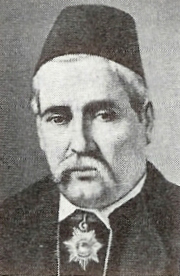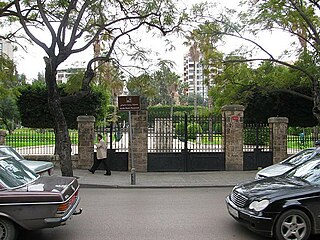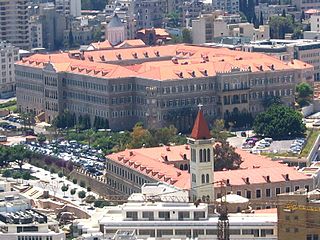Related Research Articles

Butrus al-Bustani was a writer and scholar from present day Lebanon. He was a major figure in the Nahda, which began in Egypt in the late 19th century and spread to the Middle East.
Eli Smith was an American Protestant missionary and scholar. He graduated from Yale College in 1821 and from Andover Theological Seminary in 1826. He worked in Malta until 1829, then in company with H. G. O. Dwight traveled through Armenia and Georgia to Persia. They published their observations, Missionary Researches in Armenia, in 1833 in two volumes. Eli Smith settled in Beirut in 1833.

Cornelius Van Alen Van Dyck, M.D. was an American missionary physician, teacher and translator of the Protestant Bible into Arabic.

Rue Gouraud is a mixed residential and commercial street in Gemmayzeh, a neighborhood in the Rmeil district of Beirut in Lebanon. It is named after French General Henri Gouraud. Gemmayze, and Rue Gouraud specifically, and competes with the trendy village-type neighborhood of Badaro, as one of Beirut's bohemian quarters. the district is full of narrow streets and historic buildings from the French era. The neighborhood is well known today for its trendy bars and pubs, cafes, restaurants and lounges, most of which are directly located on Rue Gouraud.
Rue Gouraud is known especially for its culinary scene that is popular with Beirut's fashionistas. The street runs east of Beirut Central District and the Saifi Village, extending from Avenue Georges Haddad and reaching the Corniche du Fleuve. In 2004, Travel + Leisure magazine called the street "SoHo by the Sea," due to its colorful and chic cafés amid 1950's apartment buildings and hole-in-the-wall shops.
Rue Clemenceau is a commercial and residential street in Beirut, Lebanon. The street was named in honor of Georges Clemenceau who accepted the post of premier of France in 1917 during World War I. The neighborhood straddling Clemenceau Street was prior to the war one of the most cosmopolitan areas of the city and home to Christians, Muslims, Druze and Jews.

The René Moawad Garden known by the public as the Sanayeh Garden is located in the Sanayeh district of Beirut, Lebanon. The garden is one of the oldest public open-air spaces in the capital. Khalil Pasha (1864–1923), commander of the Turkish Sixth Army during World War I ordered the creation of the garden in 1907.

Bliss Street, or Rue Bliss, is one of the principal streets of the Hamra area, which is within the Ras Beirut District of Beirut in Lebanon. The street, which is parallel to Hamra Street, runs east-west, connecting with Rue Clémenceau on the east and ending at Avenue General Charles de Gaulle that runs along the coast of the Mediterranean.

Hamra Street or Rue Hamra is one of the main streets of the city of Beirut, Lebanon, and one of the main economic and diplomatic hubs of Beirut. It is located in the neighborhood of the same name, Hamra. Its technical name is Rue 31. Due to the numerous sidewalk cafes and theatres, Hamra Street was the centre of intellectual activity in Beirut during the 1960s and 1970s. Before 1975, Hamra Street and the surrounding district was known as Beirut's trendiest, though in the post-war period it has arguably been eclipsed by Rue Monot in Ashrafieh, Rue Gouraud in Gemmayzeh, Rue Verdun, and downtown area. In the mid 1990s, the Municipality of Beirut gave a facelift to the street to reattract tourists all year round. Hamra Street was known as Beirut's Champs Elysées, as it was frequented by tourists all year round.

Ras Beirut is an upscale residential neighborhood in Beirut, Lebanon. It has a mixed population of Christians, Muslims and Druze individuals. Ras Beirut is associated with intersect interactions and relations in every-day life.

Rue Monnot, is a street in Beirut, Lebanon. It is located east of Beirut Central District, in the Sodeco neighborhood of the Achrafieh district, and named after Father Ambroise Monnot, a French Jesuit who founded the Saint Joseph University of Beirut in 1875.
The Crazy Horse is a cabaret venue on the Rue de Phénicie in Beirut, Lebanon. Named after the Parisian cabaret Crazy Horse, it was an infamous nightclub during the 1960s and 1970s when it was both a bar and a brothel, and considered the most outrageous of Beirut’s nightlife establishments. The venue, which was also known for its revues, was large, accommodating hundreds of tables, and the high ceiling was decorated with crystal chandeliers. Members of Lebanese and European high society, the rich and glitzy, along with politicians, spies, Arab sheikhs, and tourists mingled with the hostesses, dancers and prostitutes, making The Crazy Horse the highpoint of Beirut’s club scene by 1974. According to Adam Robinson, the author of Bin Laden: behind the mask of the terrorist, Osama bin Laden frequented the cabaret when he was a student at Brummana High School in Lebanon.
Rue de Phénicie or Phoenicia Street is a street in Beirut, Lebanon. The street runs north–south from the Mediterranean uphill to where Rue John Kennedy meets Rue Omar Daouk, intersecting along the way Rue Ibn Sina, Rue London, and Rue Rustom Pacha.
Rue John Kennedy is a street in Beirut, Lebanon. The street, originally called Rue Perthuis, was renamed in honor of President John F. Kennedy on November 30, 1963. The street, which is located in the Ras Beirut district of the Lebanese capital, is a one-way street that runs east–west from Rue de Phénicie, past Rue Nicolas Rebeiz and Rue Van Dyck, and then curving to the south along the campus walls of the American University of Beirut until it reaches Rue Clémenceau where it ends. It is primarily a residential street with some small hotels.
Rue Jeanne d'Arc is a street in Beirut, Lebanon, named in honor of Joan of Arc, one of the patron saints of France. By 1919, Rue Jeanne d'Arc was one of the main arteries that radiated from Bliss Street and by 1930, the urbanization of the street had reached 35%.

Rue Spears is a street in Beirut, Lebanon, that was named after British General Edward Spears, who in 1941 liaised with General Charles de Gaulle and his Free French movement to liberate the Levant. He was appointed the British minister in Beirut in 1942. Spears would later also urge the Lebanese and Syrians to claim independence from France after being converted to the Arab nationalist vision. Due to his initiatives, Great Britain recognized a de facto independent Lebanon in 1942.
Rue Madame Curie is a street in Beirut, Lebanon. The street, which is named in honor of Marie Curie, the Polish–French physicist–chemist, begins at Rue Badr Demachkieh in the Raouché neighborhood of the Ras Beirut district, running west–east through the Qoreitem-Snoubra neighborhood then, intersecting Rue Alfred Nobel and Rue Dunant before turning into Rue Marie Edde. The street runs south of the Lebanese American University campus. Le Bristol hotel is located on the street. In 2008, the average residential apartment price on Rue Madame Curie was US$2,500/m2.

Rue George Post is a street in Beirut, Lebanon. The street, which is located in the Ras Beirut district, was named after Dr. George Edward Post, one of the founders of the American University of Beirut. Dr. Post was professor of surgery, who also contributed to the study of ecology and vegetation of the Middle East. The residential street is located north of the American University of Beirut campus between Rue Van Dyck and Dar El Mreissé, one block south of the seaside Corniche Beirut.

Avenue de Paris is a seaside, palm-lined street in Beirut, Lebanon. The avenue, which forms with Avenue General de Gaulle the Corniche Beirut promenade, is popular with rollerbladers, cyclists and joggers.

The Phoenician port of Beirut, also known as the Phoenician Harbour of Beirut and archaeological site BEY039 is located between Rue Allenby and Rue Foch in Beirut, Lebanon. Studies have shown that the Bronze Age waterfront lay around 300 metres (330 yd) behind the modern port due to coastal regularisation and siltation. It was excavated and reported on by Josette Elayi and Hala Sayegh in 2000 and determined to date to the Iron Age III and Persian periods. Two nineteenth-century Ottoman docks were also unearthed during construction, just to the north of this area at archaeological sites BEY018 and BEY019.
Collège Protestant Français (CPF) is a French international school in Chouran, Beirut, Lebanon. It serves levels petite section through terminale.
References
- ↑ Kassir, Debevoise, and Fisk. Beirut, page 183